Over the last decade, raw dog food has grown in popularity. There are a plethora of professionally prepared diets available that are made from raw dog food. However, even with so many options, you can still feel lost when choosing the best option for your dog. Let’s look at what options you have and which meal will bring the most benefit to your canine.
Why feed raw dog food?
Feeding your dog raw, unprocessed dietary ingredients will offer them the most natural and most digestible amounts of essential nutrients, as well as support their immune systems.
Raw diets are naturally low in carbs and rich in moisture, making them ideal for canines suffering from various ailments. Meals that mirror a dog’s diet in the wild, like a wolf's diet, guarantee that our dogs are eating a species-appropriate diet that will sustain a long and healthy life.
Your pet will gain infinite nutritional benefits from feeding raw dog food if you choose the appropriate diet plan.
Best raw food for dogs
Here’s a list of raw food that is best for your dog:
Chicken
Chicken is a lean meat that offers several advantages for our canine companions. Dogs are built to use protein and fat as primary energy sources, and chicken offers that increase in a suitable ratio.
Furthermore, meals made with chicken as a primary source of protein provides a good source of nourishment for puppies.
Lamb
Protein is required by dogs to protect and regulate bodily processes as well as to grow, repair, and maintain body tissues.
Lamb is a fantastic protein source for canines, and it's becoming increasingly popular in pet foods.
Lamb is high in critical amino acids and dietary lipids, both of which aid in energy maintenance. Red meat is also high in vitamins and minerals, which aid muscular growth and promote good skin and coat health in dogs.
For dogs with dietary sensitivities or allergies caused by other protein sources, such as beef or chicken, lamb may be a suitable alternative. This meat can be quite fatty and it is recommended to start with small amounts and increase slowly.
Beef
Beef is a high-quality protein source that aids muscular growth in your pet. In addition, beef fat may make your dog feel full, and vitamins and minerals can help keep its hair and skin healthy.
Zinc, iron, selenium, and vitamins B12, B3, and B6 are abundant in beef. Feeding thinner cuts of meat to your canine will also help it maintain a healthy weight.
Venison
While venison, or deer meat, is lower in fat and cholesterol, making it a popular meat source in raw dog meals.
Venison is high in B vitamins as well as minerals, including zinc, phosphorus, and iron. It aids in the maintenance of healthy energy levels in dogs, and many of them love the flavour.
Salmon
Salmon is a common protein among dog owners and is frequently seen in dog food. This meal is a high-protein, low-fat fish high in omega oils, vitamins, and minerals.
Few dogs are sensitive to fish, making it an excellent meat for those with food allergies. In addition, docosahexaenoic acid (DHA) is essential for normal brain and eye development in pups and may be obtained by feeding foods high in omega 3 fatty acids, such as salmon.
It also helps elderly canines concentrate better, especially those who are starting to show signs of senility.
Duck
Duck is also high in amino acids, which aid in the development of strong muscles. Therefore, foods containing duck are occasionally advised for dogs with food sensitivities or allergies.
Because some canines are sensitive to chicken or beef in dog food, switching to a meal that contains a novel protein like a duck may assist in reducing gastrointestinal discomfort or skin irritation.

Kale
Besides meat, you can include vegetables in your dog’s raw meal. Kale is one of the most common options that is highly recommended for canines.
This leafy green is packed with vitamins and minerals. Cruciferous veggies are renowned as "nutrition powerhouses," with several health advantages.
Kale is abundant in vitamins K, A, and C and can help your pet have more energy, improved blood and muscle health, and a more robust immune system. It also can combat cancer and other inflammatory illnesses.
It is also a fantastic alternative if your dog is overweight as it's a low-calorie treat that's not only tasty but also excellent for your canine's digestive tract. If fed raw, we recommend you blend it, to increase nutrient absorption. Otherwise, you can lightly blanch or steam the kale to also help it be more digestible. This rule applies to most vegetables.
Carrot
Raw and cooked carrots may be a nutritious addition to your dog's diet due to their nutrient-dense qualities. In addition, the leafy greens at the top of the carrot and the rest of the carrot can be beneficial to canines.
Moreover, carrots act as an antioxidant for dogs. These chemicals aid in the reduction of free radicals in your pup's body, which are unstable atoms that damage its cells.
Free radicals not only accelerate the ageing process in your dog, they can also cause cancer. Simply said, by ingesting more antioxidants, your pet can reduce its risk of cancer.
Sweet potatoes
While sweet potatoes have grown increasingly popular in recent years, white potatoes are probably still more common. Offering sweet potatoes is a natural, safe, and healthful treat for dogs with various health benefits.
For example, they have a high dietary fibre level, which helps maintain a healthy digestive tract. They're also low in fat and high in vitamins B6, C, and A, among others.
Raw eggs
Eggs are one of nature's ideal protein sources, and they're packed with amino and fatty acids that are great for your dog's skin and hair.
Raw eggs are a superfood for dogs because they include various vitamins and minerals, including Vitamin A, Vitamin B, riboflavin, folate, iron, and selenium.
While eggs can be safely included in your dog's diet, they should never be used as their only source of nutrition. However, when used to complement a high-quality meal, eggs can be provided in moderation a few times a week. There are some concerns about the vitamin B binding avidin compound found in raw eggs. There is no need to be concerned about this though. The highest digestibility of eggs occurs with a cooked egg white and raw yolk (poached egg).
Fruits
Many fruits are safe to be eaten by your dog. One of the most popular fruits among pet parents is bananas. Bananas are high in potassium and vitamin C, as well as vitamin B6, manganese, biotin, and copper, all of which are beneficial to your dog's general health.
Bananas are also high in magnesium, which may aid in absorbing other vitamins and support healthy bone growth in your dog.
However, because bananas are heavy in sugar, they should only be given as a special treat. Green bananas, however, can be given daily because the prebiotic-rich fibres have not yet converted into sugars.
You can try other dog-friendly fruits, like apples or pumpkin, and find which works best for your canine. Always remember to consult your vet before starting anything new.

Photo by Rarnie McCudden from Pexels
How to get started feeding raw?
Raw food is typically easy to transition for dogs. Begin with small amounts of raw food, either alone or combined with their present diet.
Next, gradually increase the amount of raw food while lowering the amount of the prior diet. This can be completed in one to two weeks, although more time may be required for particularly sensitive animals.
You need to get right concerning how much raw dog food you need to provide your canine. The amount of food consumed depends on the animal's age, metabolism, and degree of activity. 2 to 4% of an adult animal's optimum body weight, split into two or three meals each day, is a reasonable general rule of thumb.
How to prepare homemade raw dog food?
Here’s a general method on how you can make your very own raw dog food:
- 80% meat of your choice
- 10% of organs
- 5% of your dog’s favourite fruit or vegetable
- 5% of supplements or dairy products
However, making raw dog food from scratch can be a challenging and time-consuming task. Additionally, if raw meat is not safely handled it can be detrimental to not only your dog’s health but also to yours.
We recommend getting pre-made raw diets. Since professionals prepare these meals, the risk of spreading bacteria in our household is little to none.
To start feeding raw, you can try Petcubes’ Raw Dog Food. Our meals are carefully made with various options you can choose from, such as chicken, venison or duck. It is also super easy and quick to make, making this alternative the best one for you, especially if you’re a beginner in raw feeding.
Conclusion
The best raw food for your dog ultimately lies in what works best for your canine. For example, some dogs love chicken, while others prefer salmon. You can always consult with your veterinarian to determine which raw food is the most suitable for your pet.
Reviewed by:
Dr Francis is one of the top wildlife nutritionists in Asia. Originating from Montreal, Canada, he left at 21 to pursue his Masters and subsequently a PhD in wildlife nutrition at Oxford Brookes University. Instead of taking the path of common animal science to learn about farm animals, or through the veterinarian space and taking a certificate in nutrition, he took the road less travelled to dive deep into the world of animal ecology, metabolism and nutrition.





